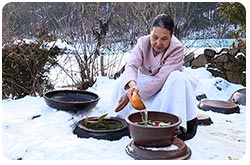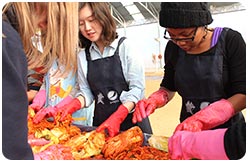Kimjang, making large quantities of Kimchi to sustain Koreans through the long winter months, has been an essential part of preparing for the long harsh seasons. A variety of socio-cultural entities also practice Kimjang for diverse purposes; sharing with less privileged neighbours, promoting cooperation among members, or educating the time-honoured tradition to the young. All Koreans are thus part of the one large Kimgjang community, which transcends regional and socio-economic boundaries within Korean society.
|  |
Over time, Koreans have developed methods that best fit their specific natural conditions. The specific methods and ingredients used in Kimjang are considered an important family heritage, transmitted from one generation to another. The preparation of Kimjang follows a yearly cycle. In spring households procure shrimp, anchovy and other seafood for salting and fermenting. In summer, they buy sea slat for the brine. In late summer, red chilli peppers are dried and ground into powder. Late autumn is Kimjang season, when communities are collectively make and share large quantities of Kimchi to ensure that every household has enough to sustain it through the long, harsh winter.
|  |
Transmitted through generations in everyday family life, Kimjang allows Koreans to practise the spirit of sharing among neighbours, while promoting solidarity and providing them a sense of identity and belonging. Kimjang could also contribute to the visibility of intangible cultural heritage by enhancing dialogue among different communities nationally and internationally that practise foodways that similarly make creative use of natural resources.
|  |






 >
>